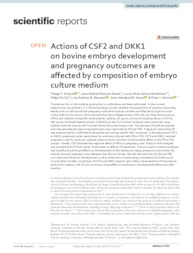Actions of CSF2 and DKK1 on bovine embryo development and pregnancy outcomes are affected by composition of embryo culture medium.
Actions of CSF2 and DKK1 on bovine embryo development and pregnancy outcomes are affected by composition of embryo culture medium.
Author(s): AMARAL, T. F.; GRAZIA, J. G. V. de; MARTINHAO, L A. G.; DE COL, F.; SIQUEIRA, L. G. B.; VIANA, J. H. M.; HANSEN, P. J.
Summary: Procedures for in vitro embryo production in cattle have not been optimized. In the current experiment, we utilized a 3 × 3 factorial design to test whether the proportion of embryos becoming blastocysts in culture and the pregnancy rate after embryo transfer are afected by type of serum in the medium [no serum; 3% (v/v) KnockOut Serum Replacement (SR); 3% (v/v) fetal bovine serum (FBS)] and addition of specifc embryokines [vehicle; 10 ng/mL colony stimulating factor 2 (CSF2); 100 ng/mL dickkopf related protein 1 (DKK1)] at day 5 of culture. Embryos were produced using abattoir-derived ovaries and Y-sorted semen from two Angus sires. The percent of putative zygotes and cleaved embryos becoming blastocysts was improved by SR and FBS. Pregnancy rate at day 30 was determined for 1426 Nelore recipients and calving rate for 266 recipients. In the absence of CSF2 or DKK1, pregnancy rates were lower for embryos cultured with SR or FBS. CSF2 and DKK1 reduced pregnancy rate for embryos cultured without serum but had no detrimental efect in the SR or FBS groups. Indeed, CSF2 blocked the negative efect of FBS on pregnancy rate. Data on birth weights were available for 67 bull calves. There were no efects of treatment. The sire used to produce embryos had signifcant and large efects on development to the blastocyst stage, pregnancy rate at day 30, calving rate and pregnancy loss between day 30 and calving. Results indicate that (1) SR and FBS can improve embryonic development in vitro while also compromising competence of embryos to survive after transfer, (2) actions of CSF2 and DKK1 depend upon other characteristics of the embryo production system, and (3) sire can have a large efect on embryonic development before and after transfer.
Publication year: 2022
Types of publication: Journal article
Unit: Embrapa Dairy Cattle
Observation
Some of Embrapa's publications are published as ePub files. To read them, use or download one of the following free software options to your computer or mobile device. Android: Google Play Books; IOS: iBooks; Windows and Linux: Calibre.
Access other publications
Access the Agricultural Research Database (BDPA) to consult Embrapa's full library collection and records.
Visit Embrapa Bookstore to purchase books and other publications sold by Embrapa.

